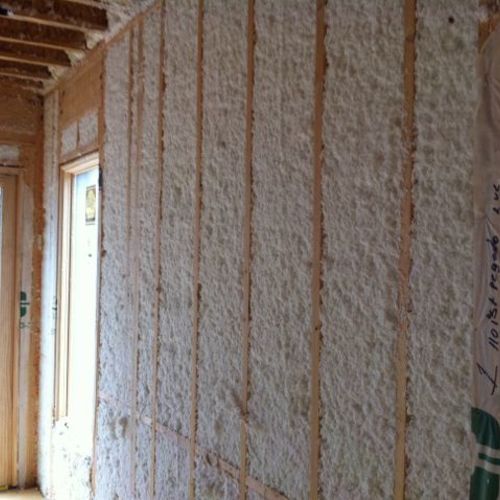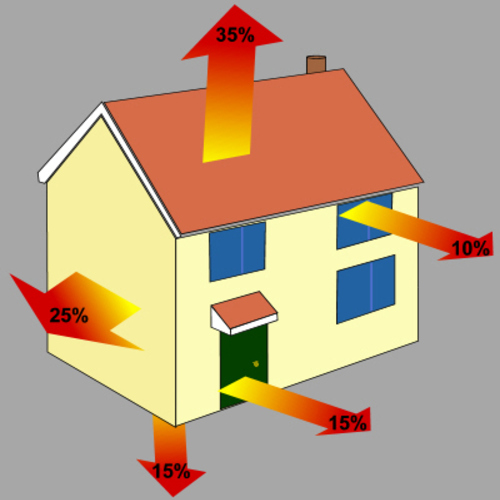
As a remodeling contractor, I’m often faced with plans that detail the finishes in full but which address the structural stuff with few details and a note saying, “Structural members to be sized by the prescriptive method.” That means I have to look in the code book and figure out what works. This isn’t stuff for greenhorns.
Up, down, and sideways
One of the keys to the kind of building I do is understanding that structure is all about direction. Gravity loads go down. That’s intuitive and easy. Most of what’s in the prescriptive structural tables in the code books deal with this, and all you need to do is read the book.
Wind loads are more interesting. Their direction is often up or sideways. This is one area where builders need help from architects and engineers because wind pressure can work in ways that aren’t intuitive. In areas with higher wind loads, that information is clearly addressed in the plans. In my region, not so much. It wasn’t long ago that I toenailed rafters to wall plates and went home. Now, hurricane ties or structural screws through the plates into the rafters are common.
Wind that pushes things sideways is interesting too. It’s why we brace walls with sheathing or diagonal members. It’s also one reason we anchor mudsills to the foundation—earthquakes are the other, but we don’t have many of them in New England.
The point is, the direction of the force determines how you have to handle it.
What else moves up, down, and sideways?
Heat, of course. It doesn’t just rise. I cringe every time I hear someone say, “Heat rises.” That statement keeps people from understanding the whole issue.
Heat doesn’t rise anymore than…
Weekly Newsletter
Get building science and energy efficiency advice, plus special offers, in your inbox.

This article is only available to GBA Prime Members
Sign up for a free trial and get instant access to this article as well as GBA’s complete library of premium articles and construction details.
Start Free TrialAlready a member? Log in















12 Comments
A few moons ago, one of the BS “Gurus” said in a presentation that hot air didn’t rise but gets pushed up by cold air. In all scheme of things, may not make a difference, but if we are talking air leaks and building envelope tightness, it can make a difference. So which is it? Air rises or its pushed-up?
All things equal, warm, moist air is more buoyant than cool, dry air and will tend to rise due to the stack effect. Does a boat float on the water or is it pushed up by the denser water below? Both statements can be true.
Not so fast Archimedes… If that’s the case, why is the air in the stratosphere colder than at sea level? But sticking with buildings, stack effect applies to buildings by how leaky they are, its height, and temperature and pressure differences that switches direction of air movements (winter vs. summer and inside vs. outside, where warm air falls).
So if we have a supper-tight building envelope (no leaks), super-insulated (no heat transfer), like a super-PHIUS houses at 0.000001ACH50, does my question still stands?... or maybe I'm just tired, or hungry, or both! 😝
Armando, when we start building houses in the stratosphere we'll have to worry about the different mechanisms up there than the ones we have to worry about relatively close to sea level. In a tight house there is much less temperature stratification than in drafty houses. I have been in enough drafty old houses and enough high-performance houses in a cold climate to confirm this is true.
It's a different scale. "Heat" is caused by molecular collisions. Outside our atmosphere, molecules are sparse (because the gravitational field becomes weaker with distance to an object) and therefore don't collide as much. In deep space, a near vacuum exists and temperatures approach 0 Kelvin. Stars such as our sun emit infrared radiation. Our sense tell us that heat must travel through space to reach us. Instead, infrared radiation excites molecules so space remains cold. When it hits the planet's atmosphere, things heat up.
The question of whether warm air rises or is it pushed up is a tautology. Less dense air (warmer) rises because it weighs less than more dense air. It is lighter than more dense air, so in a sense it is buoyed it by colder air.
The question is kind of similar to designing structural members. In most cases, the actual load is not important; what matters is the reaction load. In other words, it's not how heavy the beam is, it's how hard does the footing (or whatever) need to push to keep it in place.
Holy Cannoli! You just gave me a bad case of "Statics and Strength" class form 44 years ago... brrrrrrr 🤢
I asked this question in a physics forum a few years ago. The high level answer was that the distinction doesn't matter in any practical way. When I pressed for details, though, what I was told was this:
As particles become more energetic (heat up) they move more, resulting in larger gaps between them. Simultaneously, it gets increasingly more likely for particles to move UP against gravity, the more energy is introduced. Given this, the less energetic particles are denser and will displace the higher energy particles, effectively moving them up... but in addition, many of the higher energy particles are naturally going up already, and would do so even without the displacement. Hence... it's both that the warm air is being pushed up by the cold air AND that the warm air rises.
Worth saying that if that's wrong, then don't blame those physicists but rather my understanding of what they were telling me -- there were definitely parts of the explanations (with equations!) that I didn't fully grok.
Maybe Kohta, John, Allison or Terry will chime in... Takers?
Armando, there was a Q&A thread not too long ago that touched on stratification in really tight structures. I forget what it was titled.
The point was made that even a super tight and well insulated house can have internal stratification, but obviously it will be a lot less significant than stack effect leakage, and less significant if well insulated.
It was also pointed out that the heat (or cooling) source can make a difference. A heat source that presents a higher delta T to interior ambient (especially one that doesn't add fluid mixing) such as a woodstove, will generate relatively hotter (and less dense) air, which then rises. Oh, excuse me, I mean the colder ambient air pushes it up. ;)
I would be interested to hear how 'hot air rising' vs 'cold air pushing it up' could make a difference in practice when "talking air leaks and building envelope tightness." I think trying to come up with actual differences might yield some insights. Are you thinking tightening of the envelop up high vs down low?
I believe the point people are usually making when they say "hot air gets pushed up by cold air" is akin to saying 'nothing sucks in physics' (as my HS physics teacher always said). Atmospheric pressure governs how hard we can 'suck.' The atmosphere is pushing.
'Hot air rises' is not a complete container to work with if taken on its own. Does hot air rise in a vat of helium? Does hot air rise out into space?
Perhaps 'vacuum' rises is the closest thing to an absolute statement we could make, since that is what tops our atmosphere (don't dissect that one too much).
If there weren't cold(er) air, hot(ter) air would not rise. I.e. 'hot' air doesn't create anti gravity. And there is no such thing as hot air, only hotter and colder air. Everyone knows this, but I think that's really the point being made when people bring 'cold air pushing' into the mix. If one looks at Archimedes principle, the buoyant force exerted on an object by a fluid is the weight of the displaced fluid. Whether or not the object floats has to do with relative densities, which determines the net forces.
[Perhaps two visuals illustrate this well.
We all probably think of something like a hot air balloon when we think of hot air rising. What does it look like? Its all puffy at the top and looks like the hot air is 'pulling' the basket upwards.
But now, take a look at a picture of a bubble floating up in water. What do we see? It forms a flatter, almost concave, bottom. It looks a lot more like the water is 'pushing' the bubble upwards.
What we need to remember is that the hot air balloon has a weight hanging off of it (the basket/riders) *pulling down* on the balloon. But this doesn't mean the surrounding air isn't *pushing up* on the balloon, as is more evident with the air bubble in water.
I still contend that that phrase 'hot air rises' is accurate enough, especially in practical terms-- and the same thing happens no matter what language we use to describe it.]
As you said Tyler, knowing the differences of where, how and why we need to pay more attention to air sealing top and bottom plates, openings and penetrations, and what techniques and products work best, would be great to easily explain to framers, who are not used to reading detail on plans or studying installation instructions, the procedures we need to follow to get that low ACH.
Since I go to jobsites to work with subs, and perhaps show a better way to get things done, is that trying to come up with a simple way to explain the real reasons why we do certain processes in a different way, is a lot better than saying “because I said so”.
Besides my details, the proliferation of instructional material on the web in recent years, has made it easier to show videos and installation instruction on the field, which is helping to better results. But having said that, it’s also good to know some easier ways to explain to our crews the physics of why we do things we do.
Believe me, I get weird looks when I show or explain a simple detail to spreads a double bead of calking on sill sealer, one on top and another on the bottom, as well as when some Builders like to use, in addition, a foundation tape or liquid flashing to framing. These steps are not “typical” in our industry.
Log in or become a member to post a comment.
Sign up Log in